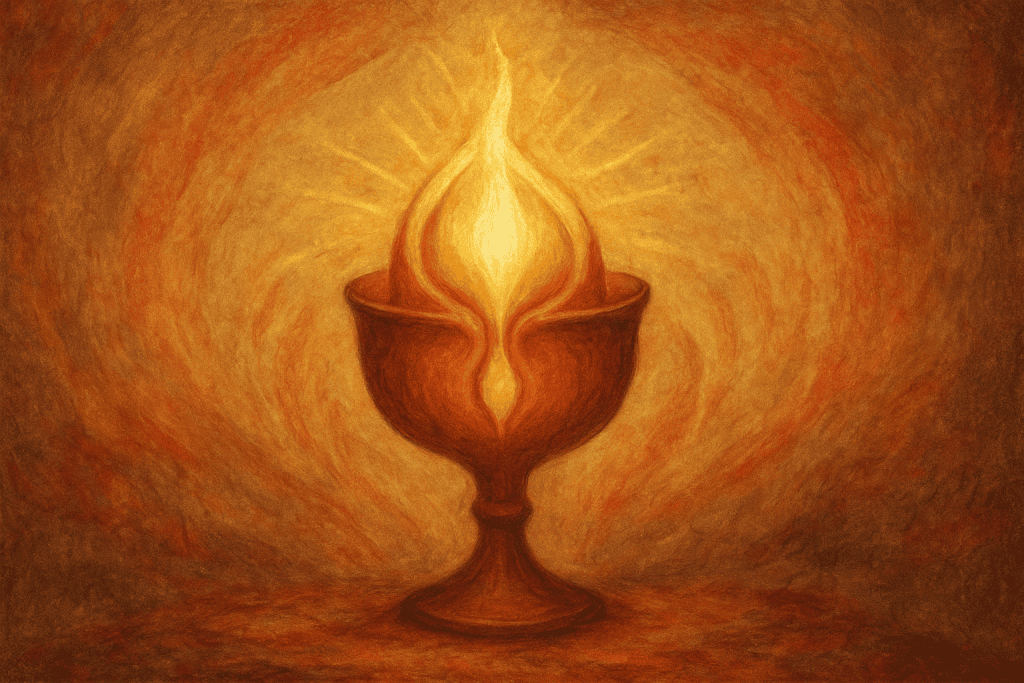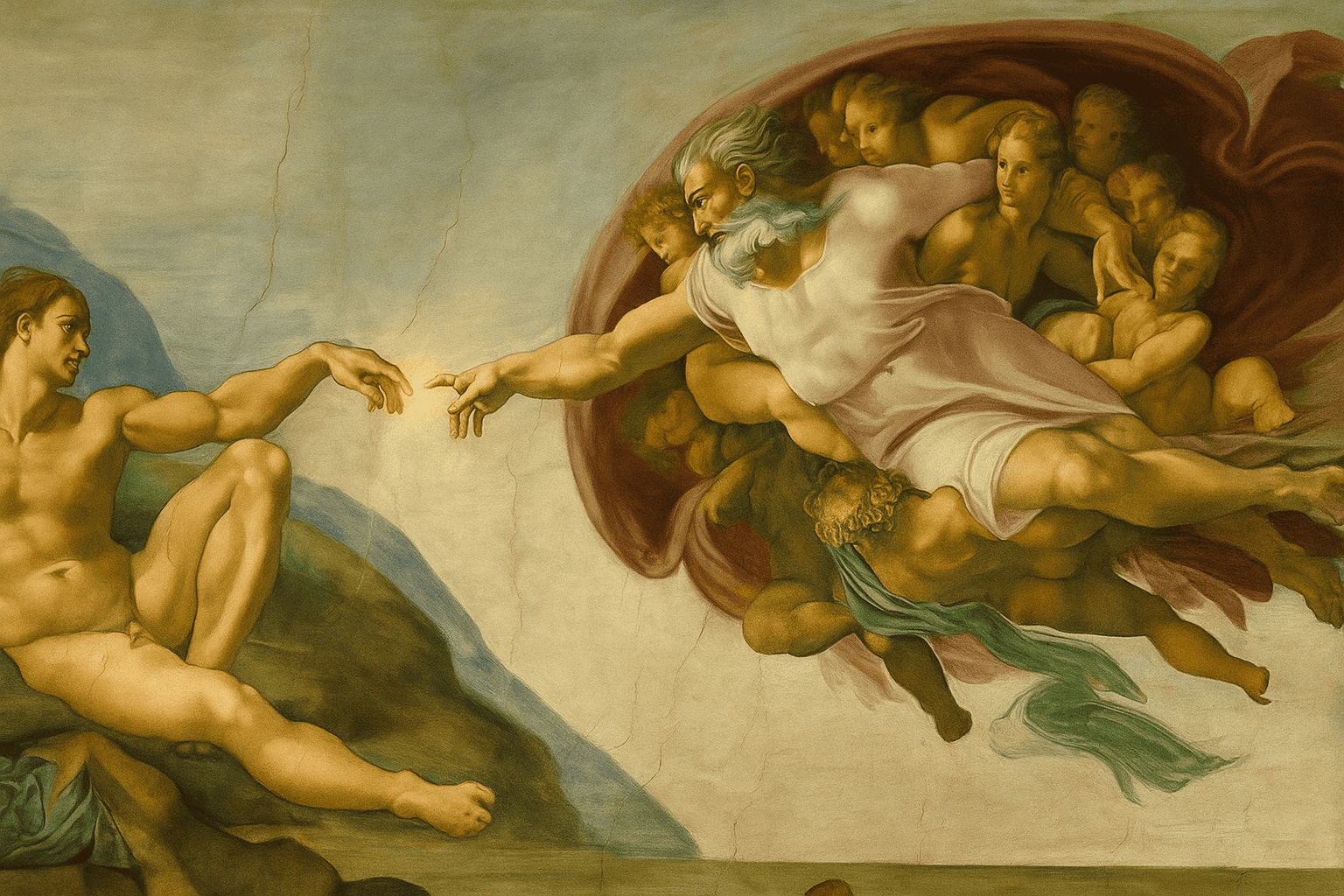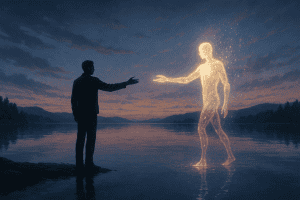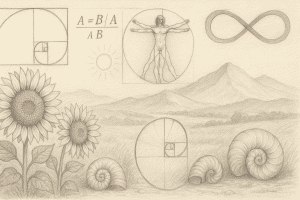1. The Keystone: The Fresco That Thinks
We all know the image: two hands reaching, a breath of space between them.
In The Creation of Adam, Michelangelo captured the instant when life passes from the unseen to the seen.
Yet within that familiar form hides another revelation—the cloak around God mirrors the shape of the human brain.
Whether or not the artist meant it, the symbol whispers a deeper truth:
the meeting point of human and divine is within the mind itself.
Behind the glowing heads, halos of light suggest that consciousness is already awake.
The pinks and reds of the robe evoke both flesh and heart, matter alive with spirit.
This is not God descending from the heavens—it is awareness rising within creation.
2. The Inner Temple
Ancient language confirms the same pattern.
The skull was called Golgotha, “the place of the skull,” where revelation occurs.
Bethlehem, “house of bread,” is the mind that nourishes spirit.
The Ark of the Covenant, carried in the temple, mirrors the brain cradled within the skull.
Each term points to one mystery: the human being as the living sanctuary of divine presence.
In this reading, Michelangelo’s ceiling is not about a distant creator but about the temple of consciousness awakening to itself.
The fresco is the architecture of the inner world.
3. The Descent into Forgetting
But vision fades. Humanity forgets that the temple is within, and truth retreats into story.
When we stopped painting ceilings, we started painting words.
Myths became the new frescoes—images for the imagination instead of the eyes.
Every tale we love carries the same seed: the soul’s descent and return to the inner light.
4. The Myths as Mirrors
In Alice in Wonderland, the fall through the rabbit hole mirrors the soul’s plunge into the subconscious, meeting riddles that test identity until awareness re-emerges.
In The Lion, the Witch and the Wardrobe, the wardrobe is a skull’s doorway, the lamppost a spark of illumination, Aslan’s death and resurrection the rebirth of divine consciousness in the heart of the child.
In The NeverEnding Story, the reader becomes the creator, discovering that imagination itself sustains the world—the same spark leaping from God’s hand to Adam’s.
Each tale is another gesture of that fresco: the divine reaching for the human, the human realizing the divine within.
5. Recognition: Seeing With New Eyes
Now the reader returns to the painting.
Look again—the arc of red cloth, the light behind the heads, the almost-touching fingers.
These are not just artistic choices; they are codes of remembrance.
Once you’ve seen their reflection in the stories, you can’t unsee them.
The fresco becomes a mirror, showing you the story of yourself:
the journey through forgetfulness, the rediscovery of light, the moment when mind and spirit meet.
“Creation was never about clay becoming flesh; it was about awareness awakening to its own breath.”
6. The Carpenter’s Cup
The current that flows between the hands doesn’t vanish; it returns—down the axis of being—into the cup.
The carpenter’s cup, carved from living wood, is more than a relic; it is the womb of the world, the vessel that receives the spark and gives it form.
Every enlightenment is a birth through matter.
The divine drinks through the vessel it creates.

“The spark passes through the mind and returns to the cup,
the vessel of flesh where light becomes life.
The carpenter’s work was not to build but to hollow a space wide enough for the divine to be born again.”
The cup is the womb, the heart, the chalice of awareness.
The mind receives the spark; the heart gives it life.
In that union, creation continues.
7. The Ongoing Creation
Look once more at the ceiling.
The hand of God still reaches, the hand of Adam still rises.
The fresco is unfinished because it waits for every onlooker to complete it.
“You were never only the one being created.
You were also the hand that reaches back,
the breath that moves between,
the painter of your own ceiling.”
And in that realization, the circle closes—the light flows from mind to heart, from art to story, from heaven to the cup.
Creation never ended; it simply learned to speak through you.
Through the Mirror Gate: The Gnosis of Reflection – Alice in Wonderland
For a reflection on how myth continues this sacred imagery, read The NeverEnding Story: A Modern Myth of Rebirth (Mythic Scribes).
For readers interested in the anatomical interpretation of Michelangelo’s fresco, see Michelangelo’s Secret Message in the Sistine Chapel: A Juxtaposition of God and the Human Brain (Scientific American).
Before saving, open your browser’s print dialog and turn off Headers and footers (the title and URL line).
Chrome / Opera / Edge: Menu → Print → uncheck Headers and footers • Firefox: More settings → turn off Print headers and footers • Safari: already clean


